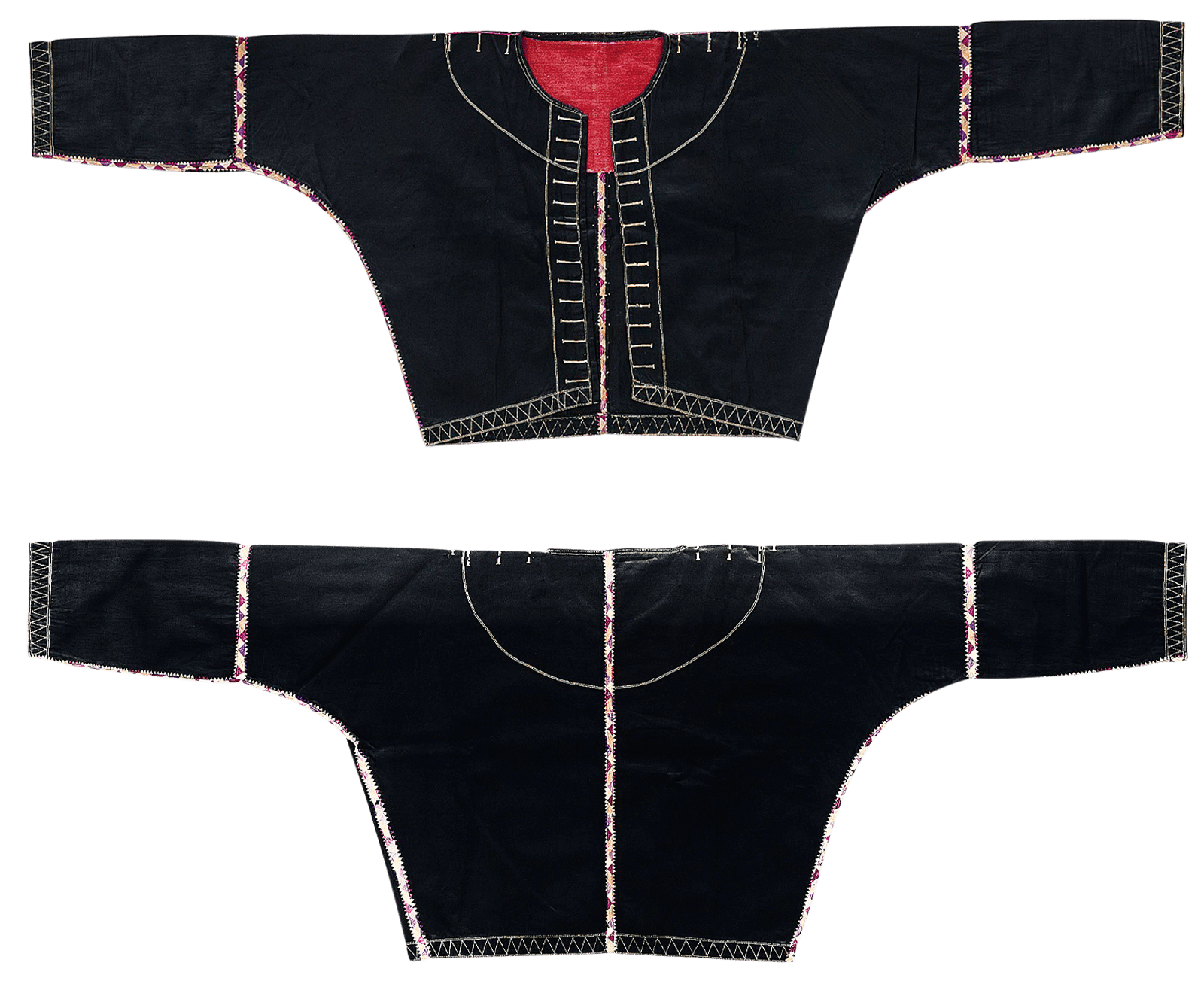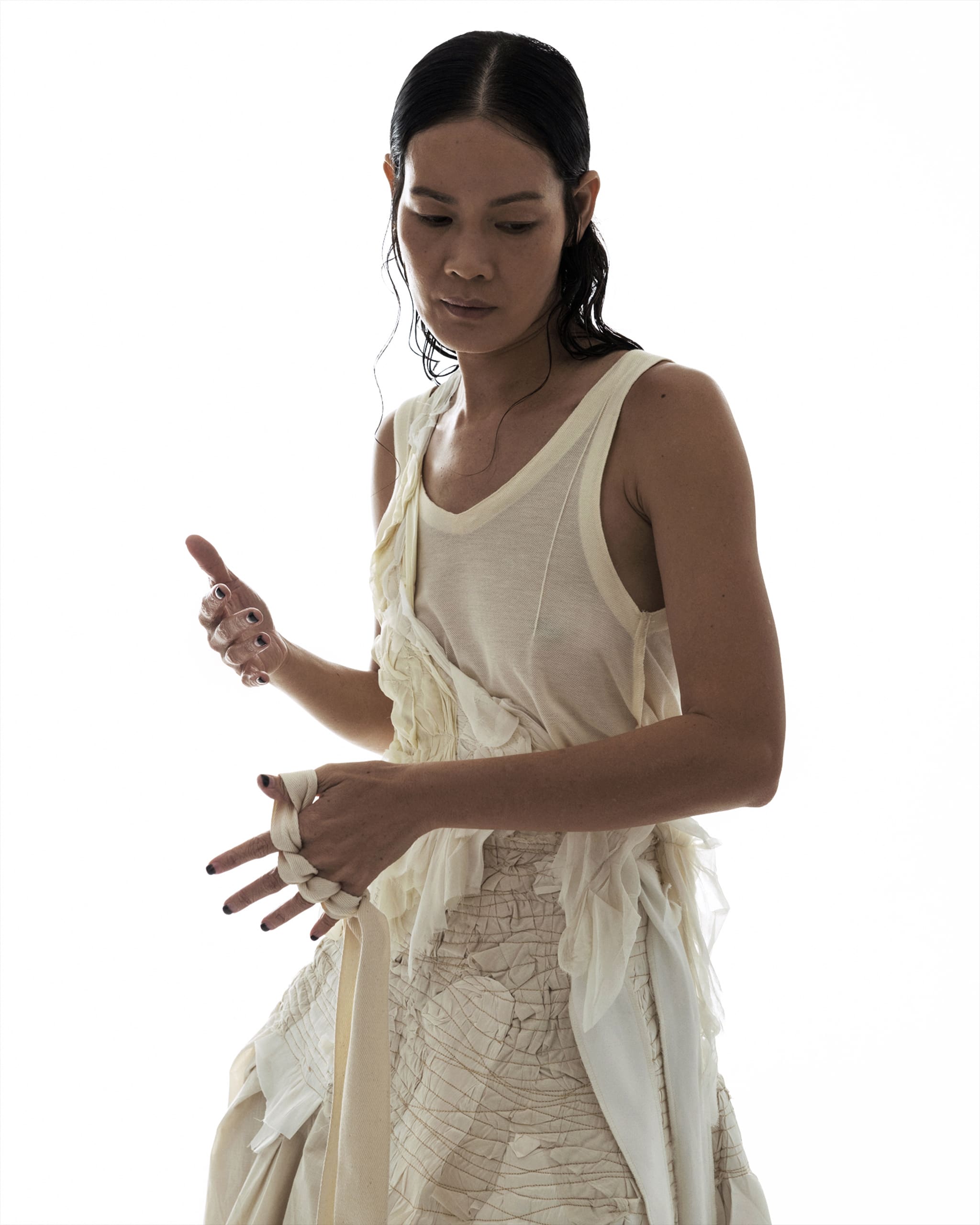Koji Arboleda
What is the way forward for Philippine fashion? Marian Pastor Roces paints a picture.
To divine the future—of fashion, of anything—it is best to discard exhausted metaphors. Little is gained now with the typical future-words: progress, forward, evolution (horrors!), advance, movement, or that worn word, trend.
I learned this bit of wisdom from a garment. It lives in an antiques collection storage with other immensely valuable traditional textiles. The cotton, long-sleeved shirt is about a hundred years old and belonged to man. He spoke Tausug and perhaps Arabic. Tausug speakers are the only language group in the Philippines that experienced central authority before Las Islas Filipinas became a nation; hence a larger-than-village character.
The construction and detail exhibit breathtaking restraint. To my mind, this aesthetic control could only have been discernible in other aspects of the owner’s life. What comes to mind is the similarly exquisite control of a martial adept. Or so we must presume. The owner would have been a fighter with considerable (and maybe superb) mastery.
This garment is to my mind a precise physical metaphor of the sustaining spirit of haute couture. High fashion, so long as it exists, can only be a virtuoso act; it can only be similar to a martial artist’s consummate power to make a killer statement.
Precision comprehension of individual bodies and body movement, a sensuous understanding of skin and bone structure, a blade-like capacity to cut through extraneous messages: the couturier and the martial artist, or any and all virtuosi, will be extraordinary or not at all.
The “future” can no longer be reckoned vis à vis “progress.” Astonishing technologies of making, say, cloths, or clothes, or weapons, or pianos, or digital equipment, alter the character of reality. Of course. But. Virtuosi will be measured—and loved—by sustaining their own dazzling mastery, in terms of their own making. They will neither be measured nor loved on the basis of progress.
Virtuosi will be measured—and loved—by sustaining their own dazzling mastery, in terms of their own making. They will neither be measured nor loved on the basis of progress.
Loss of the future
What is changing irrevocably is the notion of the future itself. The future as idea no longer exists outside the deepest uncertainty about the planet’s survival. That is to say, the future is only possible to think as conflated with a very possible futurelessness. Certainly, in fashion, there is no global superstar in couture whose aesthetic is unfocused by foreboding.
Alexander McQueen grasped doom and the embrace-of-annihilation aesthetic that doom alchemizes. Jean Paul Gaultier, Christian Louboutin, Gianni Versace, Vivienne Westwood, each in their time and in their inimitable ways, were as similarly possessed of an apocalyptic imagination as Black Sabbath, Marilyn Manson, and Lady Gaga (to be sure, of her Meat Dress Period).
The same imagination shapes someone as buoyant as Stella McCartney. The woman who grew up in a vegan family would have grown, as well, into the ecosystem of reasons for refusing to support the industrial husbanding of animals. This intellectual ecosystem hangs on a vivid comprehension of how dire the Anthropocene has become.
Yohji Yamamoto’s black, androgynous clothing channels the complexity of gender and freedom where nothing remains the same—that is to say, the planet—except in illusions of stability. The global fashion industry leaders historically yield to wisdom quickly.
Even when no one notices, wisdom suffices great design. We cannot forget, for example, that Issey Miyake was a 7-year-old in Hiroshima when the atomic bomb exploded. His survivor imagination, bodied in invented cloths that touch the wearer’s forms transformatively, committed to a defiant beauty in the nuclear age whose inauguration he personally saw.
The startling couturiers who deploy sharpness and viscerality in grasping what is going on, are among the avatars of precision thinking during apocalypse; and are among the earliest to grasp that the world as we knew it is no longer.
So, no, the small matter of trends has no bearing on what’s to happen. What’s to happen is happening now, in any case.

More insight
Curiously, the obscure Tausug shirt still yields more intelligence. By being what it’s not. Its austere elegance is provocatively at variance with fashion’s main drivers in the Philippines. Today’s decorative profusion—in the manner of outrageously bedecked figures of saints and godhead in procession—is a different Philippines from that which made that shirt.
Neither aesthetic is the essential Philippines. However, few in the Philippine fashion industry, nor, for that matter, the general population, recall the poetics of severe lines of the tradition to which the example belongs. Not even the Tausug.
There are historical reasons for the fulsome turn, during the 20th century, to the extravagantly embellished. At least a few reasons are to do with, yes, devotion to santos. And for Muslim Filipinos, the glitter of Middle Eastern material culture.
And so, the question to ask about Philippine fashion in the face of global existential threats is a quasi-religious one. Do the designers and their Filipino clientele—so used to surviving catastrophic politics and weather—feed their bravura with faith in the sparkling finery of divinities, to thus carry our flamboyant nation through the crises ahead?
Answer yes, and ask anthropologists to walk you through the back alleys of the Filipino collective mind, from church processions to fashion runways; from altars to couture spreads and spectacles featuring transcendent figures. The links are fairly obvious.
Answer no, and brave through the much more complicated social thickets of class, aspiration, politics, and society rites of passage in the Philippines. This is tough stuff.
Answer maybe (still a legit response) and consider other reasons for entirely forgetting an aesthetic of nearly mystical restraint—reasons for forgetting design as technical control, such evident in old artifacts from everywhere in the Philippines.
Defying the odds
Nearly erased from cultural memory is that command over excess that used to be the hallmark of even the heavily beaded clothing of about a century ago, from all Philippine language groups. For a long while now, baroque adornment has been the norm for designers for fiestas and, in fact, for a good number of haute couture leaders.
So: maybe. Perhaps control and restraint cannot make for a shared fashion aesthetic in a Philippines where little social value can be vested in control. Where control has been exposed as illusory—we only imagine we can determine outcomes—exaj is the trick! Exaggeration, exuberance, oomph.
The Philippine fashion message amid signs of cataclysmic change can only be released from constraints; the extreme imagination of bounty; conjurings of limitlessness. And no, this is neither nihilism nor fatefulness. It could be a defiance of the odds.
While no longer expressive of a killer instinct honed by technical control, fashion design and indeed haute couture in the Philippines may, nevertheless, also be pivoting on the same dark foreboding as global couture.
It is perfectly possible that Filipino design’s sassiness—audacity to some—could defy the very idea of the future.
This story originally appeared in Vogue Philippines’ December-January 2023 Issue. Subscribe here.
Photograpy: At Maculangan
